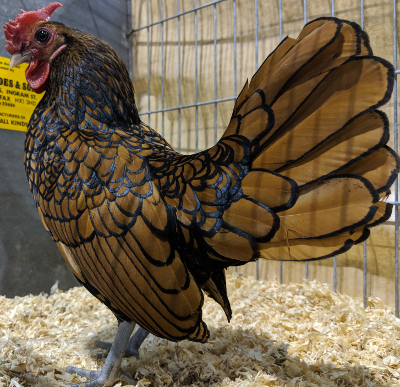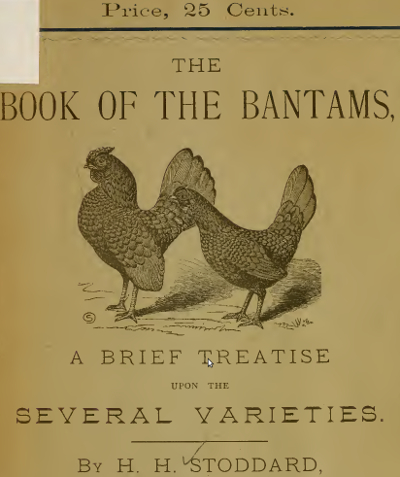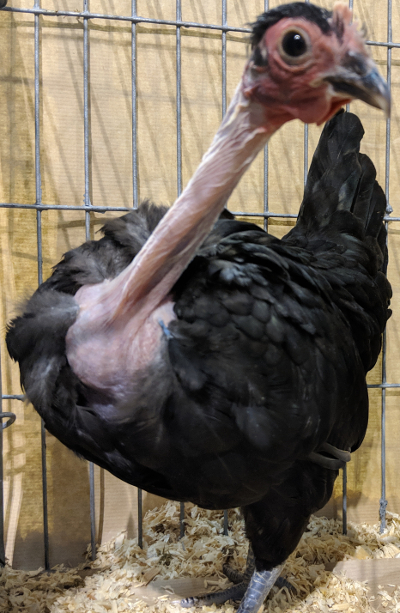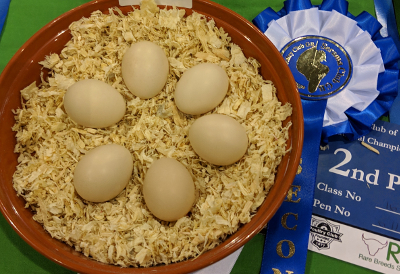Bantam chicken keeping

Bantam chickens have been part of my flock for mare than 2 decades.
What are bantam chickens:
The bantam is simply a small chicken, and the name comes from the city of Bantam. They are popular birds because they are small and come in a wide range of colours and are easy to keep.
Below: A stunning Sebright bantam.

Bantam chickens were bred for some interesting reasons. Japanese bantams came about because large eggs were all the property of the emperor and so if the general population wanted eggs they needed to settle for small ones.
Bantam chickens can be kept in smaller gardens, which makes them popular with hobbyists, fanciers or people just starting out with their flock. Bantams are used for their eggs, although their eggs are only half the size of other breeds.
Lewis wright wrote on the subject that:
"There is not the slightest reason for supposing that any of the diminutive fowls known as bantams are descended from wild stock. They are in many cases the exact counterparts of ordinary domestic breeds, carefully bred produced and dwarfed by the art of man."
There are many different breeds of this bird, each of which has its own special features. A few of the breeds are Cochin, Barnevelder, Japanese, Polish, D'uccle, Beijing, Common Bantam, Old English Game, Serama, Pekin, and Sussex.
Each different breed has different characteristics.
For example, the Pekin breed has feathers on its legs and feet, with plumage that hangs on to the ground. The polish chicken has amazing crests and a range of colours and produces pure white eggs. Both of these breeds are very popular at poultry shows.
Cochins are large, weighing up to 11 pounds, while the Barnevelder is popular for shows and the production of eggs, especially in winter, and meat.
Are you interested in bantam chicken keeping?
Many people have taken to keeping bantams as pets because of their ability to remove a large number of different insects from flower and vegetable gardens.
Bantam chickens are mostly just smaller versions of larger chickens. There are a few types that can only be found in the small size like the Serama, Japanese bantam and the Pekin. These are the true bantams with no large counterpart.
You can keep more bantams in the same space required for large fowl chickens and they still lay delicious eggs.
Bantams may well be the choice if you have children in the household.
Most bantams can be kept in the same conditions as ordinary sized chickens, there are only a few that require special care like the Serama, the Silkie and Frizzle feathered types.
Below: Bantams are often kept for ornamental reason like these beautiful Barnevelder bantams.
Below: The title page from a book of bantams from 1886 by H. H. Stoddard.

in which he writes: "They [bantams] are especially suitable as pets. Their small size enables them to be kept anywhere. Not only with the farmer or country gent who was acres of green fields but also the villager or city resident with narrow front gardens and back yards."
Why choose bantams instead of large fowl:
You will want to choose bantams over the large fowl because of their personalities. Bantams are known for their personalities, and many people describe them as having a more diverse personality than other chickens.
For their size bantams are solid and fearsome mothers and succeed in hatching most of the eggs placed under them. These birds are also very friendly and would not have problems staying with other chickens or bantams;
Bantams are also extremely curious birds and are known to notice and pay attention to everything around them. For this reason, they are very good at finding their own food and are rather biased towards insects and grasshoppers.
Below: Bantams still come in different shapes, types and sizes. This is a naked neck.

If you are interested in keeping your own chickens, bantams is a good bird to start with. Why? Its because bantams are feisty birds, and their coop does not take up much space.
Bantams are smaller birds and do not large space as other chickens, so their chicken house must be just a small one. Also, if you are aspiring to enter them into a competition, these birds are small, making it very easy to transport to and fro.
You will find that bantams will look more interesting than other chickens and are known to be very popular with children with whom they are very attached. They have very beautiful colouring, and the variety of feathering makes them very attractive as compared to regular chicken.
Bantams are good mothers and you can them becoming broody, especially in spring. Bantams are also great for hatching other eggs including those of birds, quails, and geese. Fertile hatching eggs provide a wide range of chicken breeds.
Bantam chickens eggs:
As bantams are smaller than large fowl chickens the eggs are naturally smaller than standard eggs. The size varies from 1/4 to 1/2 of the standard egg size depending on the breed.
Below: A display of Serama bantam chicken eggs that took second place in a poultry show.

In bantam eggs, the yolk is much larger than the albumen. The small size of bantam eggs doesn’t make them lesser than regular eggs. Bantam eggs are like any other egg- that is, they can be eaten, hatched and sold.
The good thing about bantam eggs is that they are cheaper than standard eggs on the market. This eggs are treated as a normal standard egg but with less cooking time.
When it is necessary to hatch, bantam eggs should be given the same care to hatch properly and to hatch as many eggs as possible.
Usually, bantam chicken eggs are treated in the same way with a standard egg. The purpose of growing bantams is to lay eggs, a source of food, a source of additional income and a medium of self-expression. Raising the bantam will benefit the owner not only through its egg but also through the pleasure of maintaining them.
The Silkie breed of Bantam is not a good egg layer but its definitely the egg hatcher you’d want to keep. The Cochin breed is an excellent egg layer that produces many eggs in different varieties of colour.
If properly fed and placed in the right coop conditions, bantams can happily be kept with and will lay eggs as frequently as their large fowl counterparts.
However, if you have bought bantams and took them in a new environment, they may not lay for a few days until they get used to the new home. Eventually, they’ll begin laying eggs daily.
Coop requirements for Bantams:
Bantam chickens are a great pet to keep in the garden at home. Not only will you receive fresh organic eggs, but you will also get a pile of high-quality garden mulch.
The requirements of the bantam coop are quite simple, and building a homemade shed is a good way to save money.
Because bantams are much smaller than ordinary chickens, your coop does not have to be so big. In fact, a single-frame coop will often serve you as well. A coop is simple to make and requires only basic raw materials, including:
• A few pieces of pine
• Chicken wire
• A hammer and some nails
Of course, keeping a larger flock, in a single frame coop may not be enough. The size that follows the single-framed coop is the medium size box cage. In many respects, they are much more practical, not to mention attractiveness. You have to invest in more building materials, but the end result is worth it.
In need of keeping a large flock? Building a complete chicken house may be what you are looking for. You can keep over 20 bantams and even attach the larger secure chicken to it. This will protect your birds from predators and / or thieves.
One of the things to keep in mind when growing bantam chickens is that they are small, making them easy prey for predators such as foxes, raccoons, cats and flying predators like the red hawk.
To prevent the problem of predators, the coop should have a perimeter wire that is buried about one foot underground, so that predators will not be able to burrow their way into the coop. To shield bantams from the problem of flying predators, the wire mesh should cover the bantams from above. This has the added benefit of preventing chickens from flying and preventing other birds that could compete for food.
While building Bantam chicken coops, it must be remembered that they must be built to provide both dry and clean housing for the bantam at virtually each developmental stage.
The major function of the house will be to offer protection against harsh weather and the most important predators. The coop could also be made such that the bantams are not injured. Bantam coops could take various shapes and sizes, mainly because of the wide variety of bantams, the climate conditions of your region, and building materials at your disposal.
A touch of elegance and style can be used in building coops, like two-story coops or eve portable coops that look like a rustic red barn. You can really vent your imagination into the design of your coop, just make sure it's solid and weather-resistant. You can even think about raising the cage, which will prevent flooding when it rains and will ensure presence of some cold when temperatures are high.
Of course, the coop should be raised high enough above the ground to allow good air circulation and also to keep the coop dry. Clean straw should be regularly supplied and changed to avoid the risk of disease.
If there is a danger of predators, proper protection using wire cables should be provided. With good care, you can expect a member of bantam chicken breed to live for about 10 years.
Remember to turn on the lighting for the coop. Bantams will require about 15 hours of daylight per day to continue laying eggs. Proper lighting helps in growth and raising egg production.
Free-ranging bantams:
Due to the increased demand for organic chicken meat, many people have adopted then organic chicken farming. The best attribute for organic farming is free range farming. Free-range bantams are allowed to roam around and obtain a natural diet, including grains.
Interested in growing purely organic bantams? The first thing that you should think of is practising free ranging farming style. Allow the bantams to roam around without enclosing them in a coop. You can train you bantams not to go too far from the coop, so you will not have to worry about their whereabouts.
What you only need to make sure in free-ranging is that you bantams are free from predators. Only allow your flock to roam outside when you are certain about the safety of the outside vicinity.
Free-range raised bantams give people a healthier choice for eggs and meat.
When to let bantams out and can you free range bantam chickens.
Feeding bantams:
Fortunately, feeding bantams and satisfying their nutritional needs is easier than housing them. People who have experience with bantam chickens say they can look after themselves better than normal chickens, such as finding food for themselves.
They spend most of their time busily scratching and picking for food. For this reason, bantam chickens are used in rural areas where there is a problem with grasshoppers and they are one of the best choices for urban and suburban chicken farmers.
Bantams do not have any special requirements when it comes to feeding. However, they require same amount of food as the larger breed, even though they are small. There is a large amount of ready bantam food that has been scientifically proven to provide all the basic nutritional needs of bantams. You can find these channels in every feed store. It is not necessary to supplement this diet, but the bantams like it.
You can feed your bantams almost anything you eat yourself - in fact, many bantam farmers use kitchen waste to feed the bantams, so the food is not wasted. Garbage leftovers of the kitchen turned into delicious eggs? Yes please!
Other supplements, such as scraped grains or regular cracked corn, are also other additions to a regular portion of pellets or mash that can be bought. Some people even plant part of their garden just for their bantams!
You can try different chicken feeds to find what your flock likes best. Chicks need special food, and the layers need a different kind. Fortunately, information about what to feed and when are always printed directly on the bag, so you know what you are feeding.
Feeders designed for bantams are easily accessible. Any way of choosing the feed for your flock depends on you, but the same rules apply to food foods that must be prevented from getting a pile and must remain dry and fresh.
Bantams always need clean, fresh water, and because they are very interesting creatures, they usually quickly throw dirt into the water. To remedy this situation, you should design the water trough in such a way that you can avoid it.
